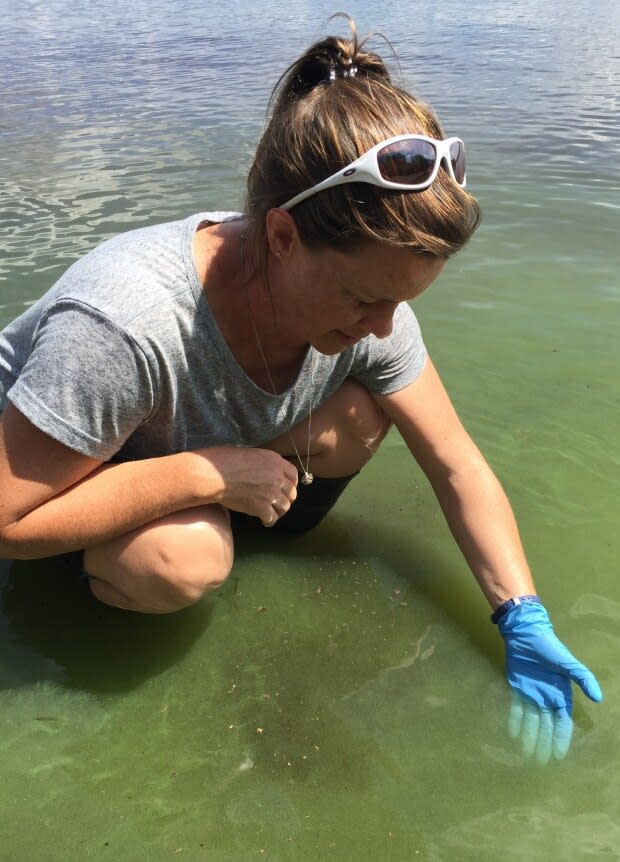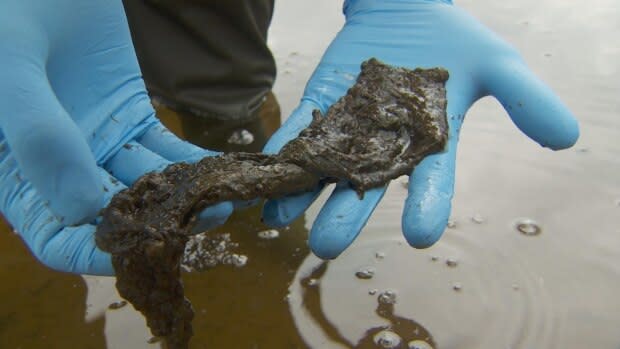Province urges public to avoid clumps of cyanobacteria in St. John River
A public health official in New Brunswick is urging people to stay away from the clumps of cyanobacteria that have been showing up in the St. John River.
Research this year has found high concentrations of neurotoxins in cyanobacteria, also known as blue-green algae, growing in the river in the Woodstock and Fredericton areas.
People can still swim and take part in recreational water activities, but they should remain cautious about what look like thick, sometimes-brown mats of decayed vegetation, Public Health says.
"We need to be aware that there are algal blooms and algal mats that can appear," said Dr. Kristen Muecke, deputy chief medical officer with the province.
This cyanobacteria that people should be most cautious lives on the river bottom, cobbles and on top of other aquatic vegetation.
This form is also found in areas with fast-moving water, something Janice Lawrence, an associate professor at the University of New Brunswick, said isn't something typically associated with algae blooms.
Cyanobacteria mats also don't always look the same. They can be brown, rust, burgundy, mossy or chalky.
"Blue-green algae is a bit of a misnomer of a term," Lawrence said. "They're actually cyanobacteria, so they're photosynthetic bacteria that live in similar environments to algae, and it's why people initially confused the two and thought they were one in the same."

What is cyanobacteria?
Cyanobacteria have existed for four billion years and can be found in rivers, lakes and wetlands, she said. In warm weather, they can form blooms that may look like scum, foam or discolorations of blue-green, green, red, brown or yellow that can appear fluorescent.
Cyanobacteria can live at the bottom of a body of water or on the surface of it.
Researchers grade cyanobacteria based on how they impact humans.
The cyanobacteria that appear at the surface is typically blue-green and produce toxins that can impact the skin and liver. Cyanobacteria that live at the bottom of the river or along the water's surface, however, produce neurotoxins, which can interfere with muscle movement and cause paralysis and suffocation, Lawrence said.

Most cyanobacteria are a healthy part of the environment and are not toxic to humans.
"A particular cyanobacteria population could have the gene for producing toxin but not necessarily be actively producing the toxin," Muecke said. "So there is a lot of moving parts with regards to figuring out what the relative risk is for any given location."
Muecke said people shouldn't ingest or swallow river water. There are other ways to be exposed to cyanobacteria, such as skin contact and inhalation, but these are not as significant as ingesting water or mats.
Geographic spread not clear
She said children, animals, people with disabilities should be supervised while swimming in the water.
Although researchers haven't been able to survey the entire 600 kilometres of the river, Lawrence said cyanobacteria were found between the Mactaquac Dam and Carleton Park in Fredericton this summer as well as in the Woodstock area.
"There are definitely toxins along the shorelines where these mats have accumulated," Lawrence said. "And the mats move, and we don't know how long the toxins may persist after the mats move."

Lawrence suspects there are cyanobacteria farther upriver and downriver, but researchers don't know how far they extend.
"We don't know how extensive it was in the past to know how rapidly it's spreading and where it is elsewhere in other river environments," Lawrence said.
A dog died last weekend after playing on an island in the river in the Fredericton area.
Tests results to determine the cause of death are expected in the next couple of weeks. Samples from the animal's stomach have been sent to a laboratory in California for testing.

"It's really important we have the information before we come to any conclusions," Muecke said.
The mats of cyanobacteria are still toxic when dried out on the riverbank, Lawrence said.
She emphasized there have been no recorded human deaths associated with the neurotoxins but said research done on lab animals indicates they do not recover from coming into contact with the toxins.
Symptoms of exposure to neurotoxins can include tremors, shaking, loss of cognitive function, and respiratory distress.
Lawrence said there is also no known treatment.
Last year, two dogs died while swimming at Carleton Park in Fredericton. A third dog died after swimming in the river near Hartt Island RV Resort, 14 kilometres west of the city.
"No one was has been hurt yet but the dog incidents are like a canary in the coal mine," Lawrence said.
"We don't know what the impacts are on people. These are smaller animals, they are more likely to engage in the material, and they are giving us a really important warning that I think we need to heed."
No data from past
Lawrence said there's no historical data on the St. John River to know what kinds of toxic levels of toxic cyanobacteria there may have been in the past.
"We do know, by looking at historical literature that there have been unexplained sudden deaths and other diseases in organisms that have come in contact with suspicious water," Lawrence said.
"But methods for detecting and analyzing samples for these kinds of toxins have only recently been developed."


